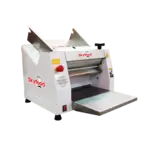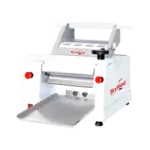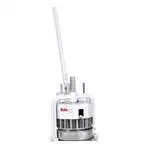
How To Effectively Clean Dough Sheeter: Maintenance & Safety Tips
Whether you’re a bakery owner, commercial kitchen operator, pastry chef, or anyone involved in food preparation, you know the significance of a dough sheeter in creating perfectly rolled dough for your delectable creations. To ensure your dough sheeter operates at its best, regular cleaning and maintenance are paramount. Additionally, prioritizing safety during the cleaning process is crucial for both the equipment and the people handling it. In this blog post, we will walk you through step-by-step cleaning procedures, essential maintenance tips, and safety precautions to help you achieve optimal performance in your baking endeavors.
Understanding Your Dough Sheeter

Before we delve into the cleaning process, it's crucial to understand the basic components of your dough sheeter. A dough sheeter is a specialized piece of baking equipment designed to flatten and shape dough evenly for various culinary applications. The main components of a typical dough sheeter include:
- Rollers: These are the key components responsible for flattening the dough to the desired thickness. Some dough sheeters have adjustable rollers to achieve different thickness levels.
- Removable Parts: These are components that can be taken out for easier cleaning and maintenance, such as catch trays or scraper blades.
- Non-Removable Components: These are parts of the sheeter that cannot be disassembled easily, such as the body and casing.
Preparing the Dough Sheeter for Cleaning

To begin the cleaning process, follow these essential preparatory steps:
1. Gather Necessary Cleaning Tools and Supplies
Before you start cleaning the dough sheeter, gather essential cleaning tools and supplies for food prep equipment. These include soft brushes, microfiber cloths, food-safe cleaning agents, warm water, and sanitizing solutions. These tools will efficiently remove dry flour and debris, maintain a clean appearance, and ensure food safety. With a well-equipped cleaning kit, you can confidently maintain your dough sheeter's optimal performance and hygiene standards.
2. Switch Off and Unplug the Dough Sheeter
Safety is paramount when cleaning any electrical appliance, including a dough sheeter. Before starting the cleaning process, make sure the machine is powered off and completely disconnected from the electrical outlet. This precaution prevents the accidental activation of moving parts and reduces the risk of electrical hazards while cleaning.
3. Ensure the Sheeter Is Cool and Safe to Touch
If the dough sheeter was recently in use, some of its components may retain heat. Before cleaning, allow the machine to cool down to a safe temperature to prevent accidental burns or injuries during the cleaning process. Working with a cool dough sheeter is not only safer but also more comfortable for the person performing the cleaning tasks.
How to Clean a Dough Sheeter: A Step-by-Step Guide

Now, let's dive into the step-by-step instructions for effectively cleaning your dough sheeter:
Step 1: Remove Excess Dough and Debris
Start by removing any excess dough or debris from the surface of the sheeter. Use a soft brush to gently sweep away loose particles. Be thorough in this step, as leftover dough can impact the sheeter's performance and hygiene.
Step 2: Disassemble Removable Parts for Thorough Cleaning
Carefully disassemble any removable components of the dough sheeter, such as rollers and catch trays. Refer to the manufacturer's instructions for proper disassembly and reassembly. Cleaning these parts individually ensures a more comprehensive cleaning process.
Step 3: Clean Non-Removable Components
For non-removable parts, use a microfiber cloth and a food-safe cleaning agent to wipe down the surfaces. Pay special attention to areas where dough and debris may accumulate. Cleaning the non-removable components helps eliminate residue buildup.
Step 4: Address Hard-to-Reach Areas and Crevices
Use a soft brush or a cloth wrapped around a small tool to reach and clean tight spots and crevices that are difficult to access. These hidden areas are prone to collecting debris and should not be overlooked during cleaning.
Step 5: Properly Sanitize the Surfaces to Ensure Food Safety
After cleaning, sanitize all surfaces with a food-safe sanitizing solution to eliminate any remaining bacteria and ensure food safety. This step is vital, especially if the dough sheeter comes into direct contact with food.
Maintenance and Care Tips for the Dough Sheeter

Proper maintenance is crucial for the longevity of your dough sheeter and its efficient operation. Follow these maintenance tips:
1. A Regular Cleaning Schedule
Establishing a regular cleaning schedule is essential to keep your dough sheeter in top condition. After each use, remove any dough residue, flour, or debris from the machine's surfaces. Pay special attention to areas like rollers, belts, and cutting mechanisms. Regular cleaning prevents the build-up of sticky dough, which can affect the sheeter's performance and lead to hygiene issues.
2. Adjustment of the Sheeter for Smooth Operation
Check and adjust the settings and alignment of the dough sheeter regularly. Misaligned rollers or improper settings can result in uneven rolling and potentially damage the machine. Follow the manufacturer's instructions for adjusting the sheeter to ensure smooth and even dough rolling.
3. Inspection for Signs of Wear and Tear
Perform routine inspections to detect any signs of wear and tear. Check for loose or damaged parts, frayed belts, and worn-out components. Addressing these issues promptly can prevent more significant problems and downtime later on. Regular maintenance and timely repairs will extend the lifespan of your dough sheeter.
4. Storage and Covering Guidelines to Prevent Dust & Contaminants
When the dough sheeter is not in use, store it in a clean, dry area away from moisture and direct sunlight. Using a protective cover will prevent dust, flour, and other contaminants from settling on the machine's surfaces. This helps maintain hygiene standards and ensures the machine is ready for use when needed.
Safety Precautions for Cleaning a Dough Sheeter
Maintaining safety while cleaning your dough sheeter is of utmost importance. Make sure to follow these safety precautions:
1. Following Safety Protocols During Cleaning
Always follow the manufacturer's safety guidelines and protocols while cleaning the dough sheeter. Familiarize yourself with the machine's specific cleaning instructions to avoid accidents and ensure the safety of both the operator and the equipment.
2. Safe Handling of Cleaning Agents and Chemicals
When using cleaning agents or chemicals to clean the dough sheeter, exercise caution. Read and follow the instructions provided by the manufacturer or the cleaning agent's label. Wear appropriate protective gear, such as gloves and goggles, to protect your skin and eyes from potential chemical splashes or irritation.
3. Protective Gear and Measures to Prevent Accidents
Prioritize safety during the cleaning process by wearing protective gear. Aprons help shield clothing from spills and stains, and closed-toe shoes protect from slipping or potential injury if something falls on your feet. Additionally, ensure the machine is powered off and unplugged before cleaning to avoid accidental activation of moving parts.
To Wrap Up!
In conclusion, properly cleaning and maintaining your dough sheeter is essential for its optimal performance and longevity. By following the step-by-step cleaning procedures and adhering to the safety precautions outlined in this article, you can ensure a hygienic environment in your commercial kitchen and uphold food safety standards. Regularly inspecting and addressing wear and tear will help prevent breakdowns and costly repairs, ensuring your dough sheeter continues to produce perfectly rolled dough for your delectable creations.
Remember to gather the necessary cleaning tools and supplies, switch off and unplug the sheeter, and allow it to cool down before starting the cleaning process. Disassemble removable parts for thorough cleaning and pay attention to hard-to-reach areas and crevices. Sanitize all surfaces to maintain food safety standards.
By maintaining your dough sheeter, you can maximize its efficiency, extend its lifespan, and consistently deliver high-quality baked goods to your customers. Always refer to the manufacturer's guidelines for specific cleaning and maintenance instructions. With a well-maintained dough sheeter, you can elevate your baking endeavors and ensure the success of your culinary business.
FAQ
How do I clean a dough sheeter belt?
Cleaning the dough sheeter belt involves using a soft cloth or brush with a food-safe cleaning agent to remove debris and dough residues gently. Avoid using harsh chemicals that might damage the belt material.
How do I maintain a dough sheeter?
Regularly clean, inspect, and adjust your dough sheeter. Follow the manufacturer's maintenance recommendations and schedule professional servicing when needed.
What should I look for in a dough sheeter?
When choosing a dough sheeter, consider factors such as size, capacity, roller material, ease of cleaning, and safety features.
What is involved in cleaning the dough sheeter?
Cleaning the dough sheeter involves removing excess dough and debris, disassembling removable parts, cleaning non-removable components, addressing hard-to-reach areas, and sanitizing all surfaces.
What is the difference between a dough roller and a dough sheeter?
A dough roller is a manual or motorized device that flattens dough to a desired thickness, while a dough sheeter is a more complex machine that can also be used to stretch and shape the dough evenly.



